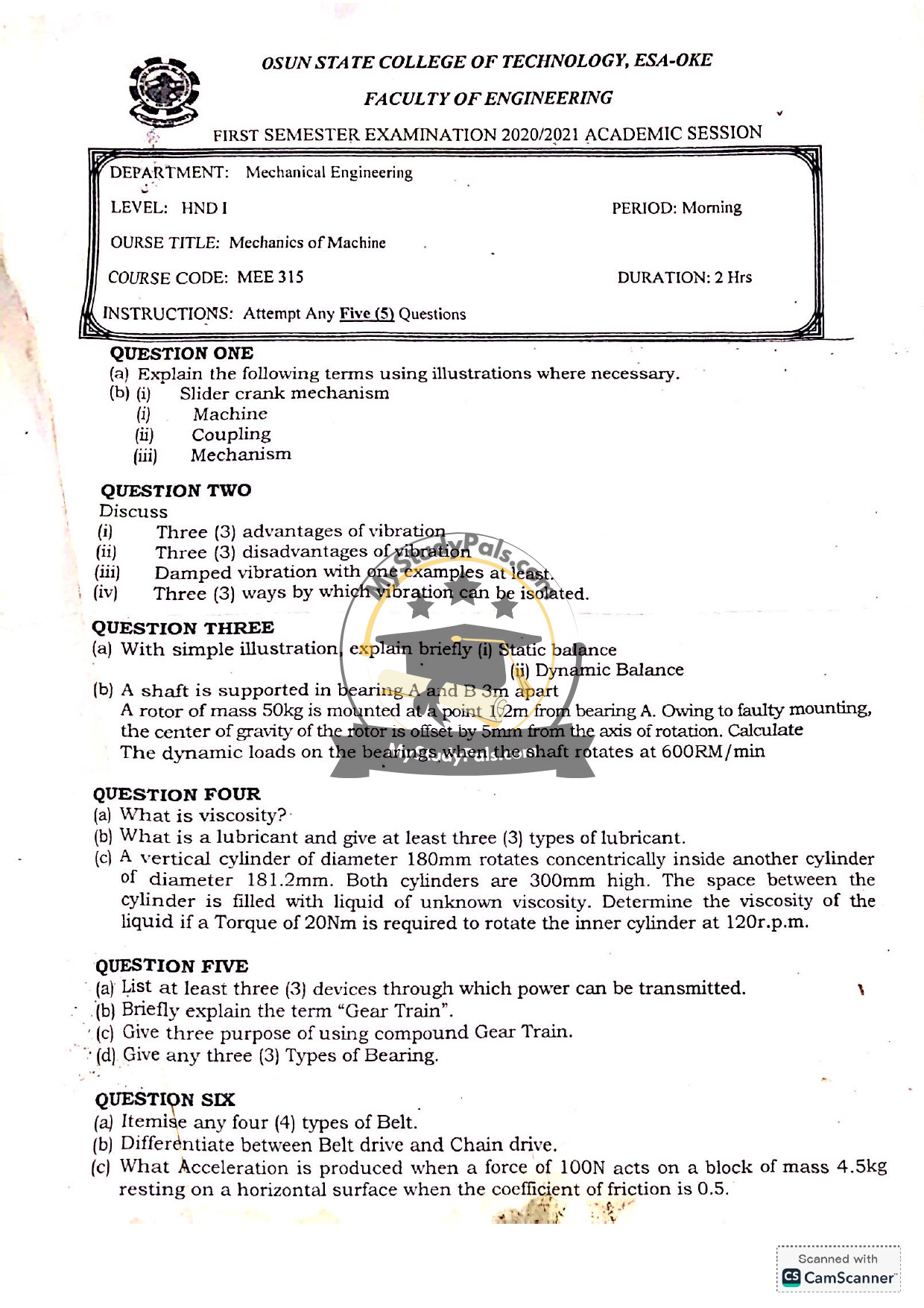ANWSER
Question 1:
(i) Slider Crank Mechanism:
A mechanical system converting linear motion to rotational motion (or vice versa). Consists of a crank, connecting rod, and slider. Example: Piston engine.
(ii) Machine:
A device using energy to perform tasks via mechanisms. Examples: Engines, pumps.
(iii) Coupling:
Connects two shafts to transmit power, allowing misalignment. Types: Rigid, flexible.
(iv) Mechanism:
Parts working together to transform motion/force. Examples: Gears, linkages.
—
Question 2:
(i) Advantages of Vibration:
1. Used in vibrating screens for material sorting.
2. Ultrasonic cleaning.
3. Massage devices.
(ii) Disadvantages of Vibration:
1. Causes wear and tear.
2. Noise pollution.
3. Structural damage risk.
(iii) Damped Vibration:
Vibration energy dissipates over time. Example: Car shock absorbers.
(iv) Vibration Isolation Methods:
1. Rubber mounts.
2. Spring isolators.
3. Damping pads.
—
Question 3:
(a)
– Static Balance: Center of mass aligns with rotation axis (no rotation when stationary). Example: Balanced wheel.
– Dynamic Balance: No unbalanced forces during rotation. Example: Car tire balancing.
(b) Dynamic Load Calculation:
– Angular velocity: \( \omega = \frac{2\pi \times 600}{60} = 62.83 \, \text{rad/s} \).
– Centrifugal force: \( F = 50 \times 0.005 \times (62.83)^2 \approx 987 \, \text{N} \).
– Bearing reactions:
– \( R_B = \frac{987 \times 1.2}{3} \approx 394.8 \, \text{N} \).
– \( R_A = 987 – 394.8 \approx 592.2 \, \text{N} \).
Answer: Dynamic loads: \( R_A = 592.2 \, \text{N}, \, R_B = 394.8 \, \text{N} \).
—
Question 4:
(a) Viscosity: Fluid’s resistance to flow.
(b) Lubricant: Reduces friction. Types: Oil, grease, solid (graphite).
(c) Viscosity Calculation:
– \( \omega = 12.566 \, \text{rad/s}, \, T = 20 \, \text{Nm} \).
– Formula: \( \mu = \frac{T (r_2 – r_1)}{2\pi \omega r_1^3 h} \).
– Result: \( \mu \approx 0.694 \, \text{Pa·s} \).
—
Question 5:
(a) Power Transmission Devices: Belts, chains, gears.
(b) Gear Train: Gears transmitting power between shafts, altering speed/torque.
(c) Compound Gear Train Purposes:
1. High speed reduction.
2. Transmit power over distances.
3. Change rotation direction.
(d) Bearing Types: Ball, roller, plain bearings.
—
Question 6:
(a) Belt Types: Flat, V-belt, timing, round.
(b) Belt vs. Chain Drive:
– Belt: Quiet, slips, flexible.
– Chain: No slip, efficient, requires lubrication.
(c) Acceleration Calculation:
– Friction force: \( 0.5 \times 4.5 \times 9.81 \approx 22.07 \, \text{N} \).
– Net force: \( 100 – 22.07 = 77.93 \, \text{N} \).
– Acceleration: \( \frac{77.93}{4.5} \approx 17.32 \, \text{m/s}^2 \).
Answer: \( 17.32 \, \text{m/s}^2 \).


